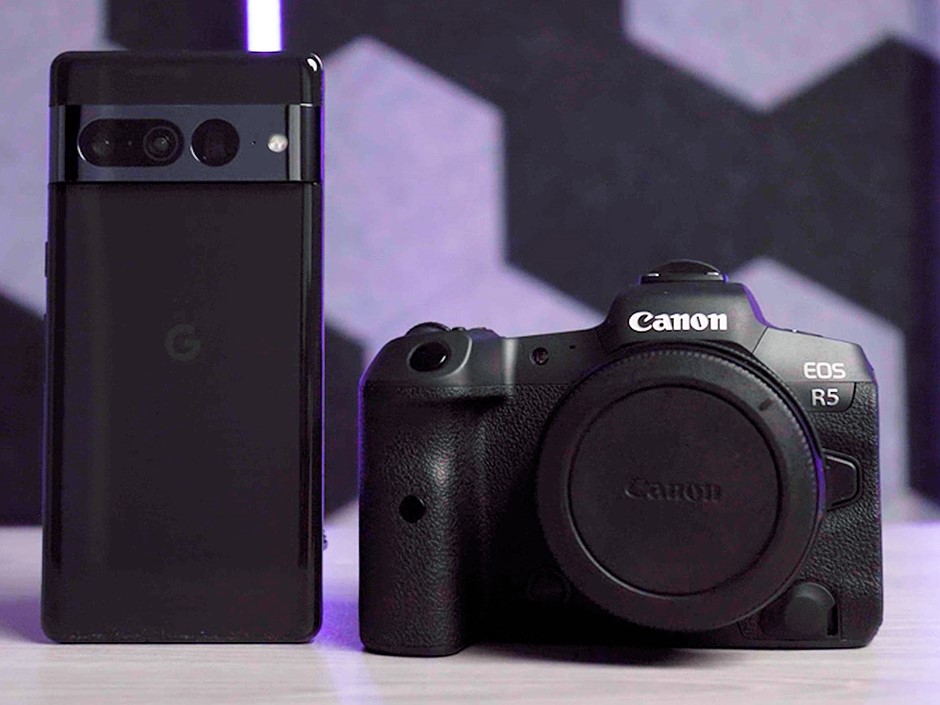
[ad_1]
The gap between smartphones and dedicated camera systems continues to shrink. Last month, we wrote about a Qualcomm executive claiming that AI will help smartphones surpass interchangeable lens cameras. Smartphones aren’t quite there yet. However, as Kevin Raposo, also known as the Speedy Photographer, shows in a new video, recent smartphones like the Google Pixel 7 Pro can hold up against professional cameras in certain situations. Can you tell the difference between an image shot with the Pixel 7 Pro versus the Canon EOS R5?
The Google Pixel 7 Pro has three rear cameras, a 12MP ultrawide camera, a 48MP telephoto camera and a 50MP main camera. The main camera has a 25mm equivalent lens with an F1.9 aperture. The lens is paired to a Type 1/1.31 (9.8 x 7.4mm) image sensor. In the other corner is the Canon EOS R5. It uses a 45MP full-frame Dual Pixel CMOS image sensor. The two cameras are pretty close in terms of megapixels. To try to match up focal lengths, Raposo is using a few Canon lenses, including 16-35mm, 24-70mm and 70-200mm zooms. For the comparison, all images are captured in JPEG format, and editing is limited to cropping and exposure adjustments to ensure the images match up. As for videos, they’re all 4K/60p and are straight from the camera.
The first test is a couple of ultra-wide images. In this situation, at a glance, the photos look very similar, even when viewed at 4K. However, as Raposo shows, when you investigate the corners, it’s clear that the Pixel 7 Pro lacks the sharpness across the frame delivered by the R5 and the 16-35mm zoom lens. Of course, the ultrawide camera on the Pixel 7 Pro is only 12MP, so a difference in resolution is clear when viewing the images up close.
The standard lens comparison is different because the Pixel 7 Pro features a 50MP image sensor. That means it has even more megapixels than the much larger sensor in the Canon R5. The Pixel 7 Pro’s portrait mode is impressive, but when you view images up close, the processing can come up a bit short around the subject’s edges. At the same time, the R5 isn’t doing fancy masking or processing, instead relying on optics and delivering a clean image. In challenging light, the Pixel 7 Pro’s HDR technology results in a pretty good image but with obvious areas of excessive processing. However, in one comparison scene, the Pixel 7 Pro comes remarkably close to matching the R5. The images are genuinely difficult to tell apart.
| Which image is captured by which camera?
Final chance to guess. It’s the Canon EOS R5 on the left and the Google Pixel 7 Pro on the right. |
As you increase the focal length, the differences between the smartphone and the full-frame camera system become more evident. There’s a massive rift between telephoto optics in a smartphone paired with a very small image sensor versus a large image sensor with a long lens full of sophisticated lens elements. Still, as Raposo points out, the Pixel 7 Pro impresses, even if it can’t keep pace with the Canon R5.
When it comes to video, the Pixel 7 Pro performs heavy processing, and the resulting video is quite compressed, so the difference is quite noticeable. While video straight from the smartphone may look more vibrant, there’s a stark contrast in sharpness. Plus, there’s a lot of data coming from the R5, so there’s a lot you can do with the file during post-processing that’s impossible when dealing with the video from the Pixel 7 Pro.
If you kept score, how many of Raposo’s comparison shots did you guess correctly? Of course, it might’ve been easier if you had access to full-size images, but that highlights an interesting question. How often do you view images at full-size? Many photographers share their images primarily online and on social media. If you saw Pixel 7 Pro and Canon R5 images on Instagram instead of YouTube, they could be even harder to tell apart, especially at wide to standard focal lengths and when shot in good light.
The Pixel 7 Pro and the Canon EOS R5 aren’t designed for the same customer. Enthusiasts and pro photographers aren’t itching to sell their gear and switch to using smartphones. The image quality from a camera like the Canon R5 is clearly superior to what you get from smartphones, even impressive ones like the Pixel 7 Pro. However, Raposo’s comparison shows that the gap between smartphones and cameras continually narrows. Smartphones have come up a long way.
As we’ve seen in another of Raposo’s comparison videos pitting the Galaxy S21 Ultra’s 108MP camera versus a 20.2MP Canon EOS 1DX Mark II, image quality is more than megapixels. However, even though smartphones’ smaller image sensors and lenses keep them from matching interchangeable lens cameras like the R5, better processing and more sophisticated computational photography features undoubtedly make it a closer fight. For photographers who don’t perform heavy editing to raw files or don’t make large prints, the difference between the newest smartphones and modern digital cameras may hardly even be noticeable.
To see more from Kevin Raposo, visit his YouTube channel and follow him on Instagram.
[ad_2]
Source link







